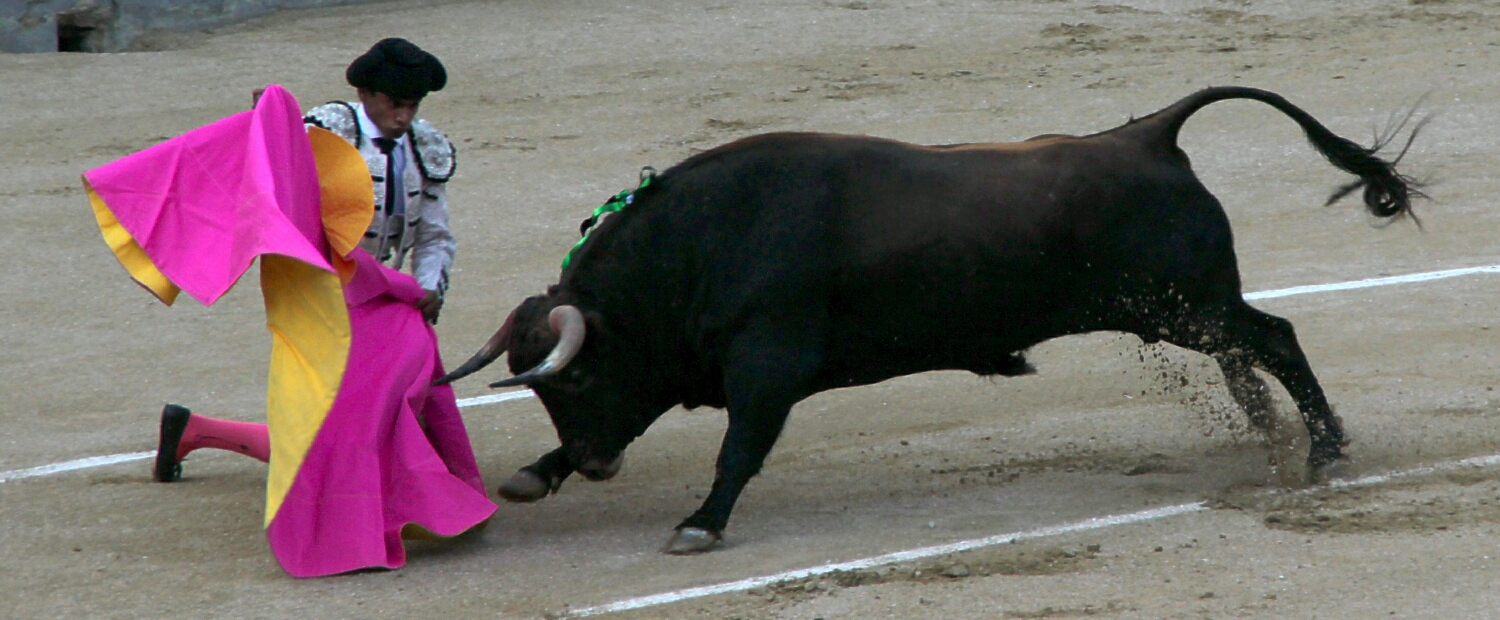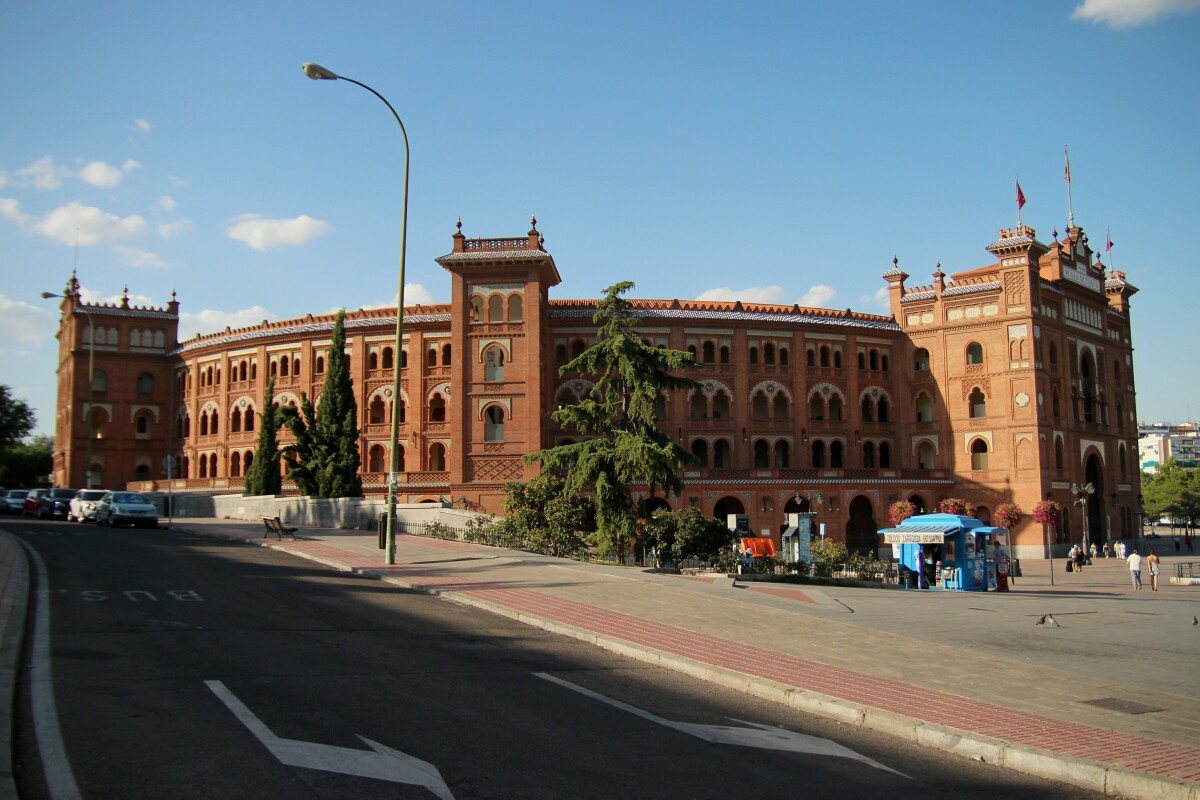If you do not like blood or the torture of animals (because a bullfight is really ritualized torture, but then so are many UFC mixed martial arts and boxing matches), now is a good time to leave this section.
On the evening of Day 4, I took in the bullfights at Plaza de Toros, right beside my hotel. The fights happen each Sunday night until October.
A bullfight is a competition between matadors, which follows a tight ritual. Let us consult the source of all knowledge, Wikipedia, for an explanation.
A "corrida" consists of 6 bullfights, with 3 matadors each performing in 2 fights. There are three stages to a bullfight. It should take about 2 hours.
On this evening it took almost 2.5 hours.
A matador has six assistants — two picadores ("lancers") mounted on horseback, three banderilleros ("flagmen"), and a mozo de espada ("sword servant").
In Stage 1 – Tercio de Varas ("part of lances"), the matador observes how the bull charges as capes are thrust by the banderilleros.
The initial attack by the matador is called suerte de capote ("act of the cape"), and there are a number of fundamental "lances" or passes that matadors make.
Next, two picadores enter the arena, each armed with a lance or vara. The picadores are mounted on large heavily padded and blindfolded horses.
The bull is encouraged to attack the horse which is protected by its padding and appears to treat the attack with stoic patience.
The picador stabs a mound of muscle (morrillo) on the bull's neck leading to the animal's first loss of blood.
As the picador stabs the top of the bull with the lance, the bull charges and attempts to lift the picador’s horse with its neck muscles.
This causes further weakening of the neck. If the picador does his job well, the bull will hold its head and horns lower during the following stages of the fight.
This stage is a mandatory step in the corrida, and regulations require that the plaza judge ensures a certain number of hits are made before it is completed.
In Stage 2 – Tercio de Banderillas ("part of banderillas"), the three banderilleros each attempt to plant two barbed sticks (banderillas, literally "little flags"
as they are decorated with paper in the local colors) in the bull's shoulders. These further weaken the enormous ridges of neck and shoulder muscle through loss of blood,
while also frequently spurring the bull into making more ferocious charges. By this point the bull has lost a significant amount of blood and is usually exhausted.
The matador then enters with his cape and sword, tiring the bull further with several runs at the cape.
In Stage 3 – Tercio de Muerte ("part of death"), the matador re-enters the ring alone with a small red cape or muleta in one hand and a sword in the other.
This cape is stretched with a wooden dowel and, in right-handed passes, the sword as well. The matador uses his cape to attract the bull in a series of passes,
both demonstrating his control over it and risking his life by getting especially close to it. The red colour of the cape is a matter of tradition, as bulls are actually color blind:
they attack moving objects (the real reason that a red colored cape is used is that any blood stains on it will be less noticeable).
There are a number of distinct styles of passes, each with its own name. Spectacular passes are celebrated by the audience with shouts of "ole!".
The faena ends with a matador with a muleta attempting to manoeuvre the bull into a position to stab it between the shoulder blades and through the aorta or heart.
The act of thrusting the sword (estoca or estoque) is called an estocada.
If estocada is not successful, the matador must then perform a descabello and cut the bull's spinal cord with a second sword called verdugo
(this happened four out of the six matches during this evening)
to kill it instantly and spare the animal further pain. Although the matador's final blow is usually fatal, it may take the bull some time to die.
A coup de grâce is therefore administered by a peón named a puntillero, using a dagger to further pierce the spinal cord.
The bull's body is dragged out by a team of mules. If the presidente is impressed by the performance of the bull, he orders a tour around the ring to honour the animal.
Very rarely, a bull will be allowed to survive a fight as an indulgence granted in recognition of an exceptional performance.
The spectators will demand an indulto from the presidente, by waving handkerchiefs before the estocada and the bull will be "freed".
Such bulls are generally retired from competition and raised as studs, as their experience in the ring makes them extremely dangerous opponents. |

Above: The matador in Stage 1 runs the bull in the first match. The red cape does not come out to play until Stage 3 - hot pink capes are used by all.
Below: Pictures 1 to 4 show the outside and inside of the Plaza de Toros stadium, used for music concerts and other events when not used for bullfighting.
Pictures 5 to 7 are the judges of these competitions, and the entire group of matadors, picadors, bandilleros and mozo de espadas.
Pictures 8, 9, 12 and 13 show the matador in Stage 1 running a series of passes, and the bull pawing the ground ready to charge.
Pictures 10 and 11 show a picador stabbing the bull, as the bull tries to gore the horse.

|
|